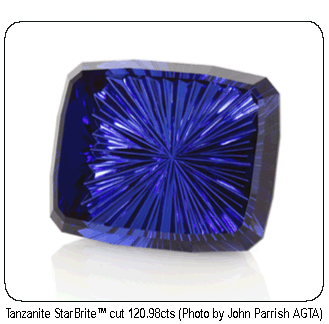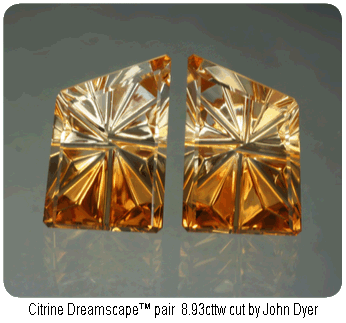The Daily Grind
By Geoffrey Dominy of the World Gem Foundation
May 2017
May 2017
John Dyer has been cutting gems for over 20 years (since the age of 17). During this time he has won over fifty gem cutting awards including fourteen first prizes. Additionally, John is the only gem cutter who has swept all the awards in one category of the AGTA competition, which he did in 2005, 2007 & 2015.
 John’s
goal is to craft each piece of gem rough into a finished gem that
reaches its maximum potential for beauty and market appeal. Working
towards this goal he uses a wide variety of cutting styles and
techniques each adapted to the individual piece of rough that he is
working on at the time. This challenge is the part of gem cutting that
he most enjoys and his enthusiasm and care is visible in the gems he
cuts.
John’s
goal is to craft each piece of gem rough into a finished gem that
reaches its maximum potential for beauty and market appeal. Working
towards this goal he uses a wide variety of cutting styles and
techniques each adapted to the individual piece of rough that he is
working on at the time. This challenge is the part of gem cutting that
he most enjoys and his enthusiasm and care is visible in the gems he
cuts. GT: Artist or Gem Cutter; Gemstone or Art?
JD: The short answer is both! The art is nothing without a quality natural mineral to cut into a gemstone, but the natural mineral is also often unattractive and unappealing without the care of the gem cutter’s art. While there are some natural crystals which have their own beauty the majority of gems mined are either worn or broken in such a way that many of the people I show them to outside of the trade say they wouldn’t pick them up if they found them lying in the street. Once cut however these same people ‘ooh’ and ‘ahh’ over them and often pay substantial amounts of money to own them. That is a big transformation from not being something that seemed worth picking up in the street!
GT: What is the most challenging gemstone you have ever cut?
JD: The next one! Each gem presents its own challenges and once they have been overcome they seem easier. However, often when I am thinking about cutting them and planning what to do the challenge seems larger than once it has been completed.

The tanzanite that I recently cut and won an AGTA Cutting Edge Award with was one of the ones I recall recently being a big challenge. Many of the techniques I use generate a certain amount of heat and tanzanite is a heat sensitive gem so that is nerve-wracking. Just to make matters tenser, this gem started to open up with small cracks in a certain crystal direction. I lost some sleep over that! But thank God I managed to remove the cracks by changing the design a little bit (and losing probably 10-18 carats in the process) and finish the gem without any of the cracks left in it. It is much less stressful to remember the project than it was to actually execute it.
GT: What is the most enjoyable gemstone you have ever cut?
JD: My favorites are beryls (especially aquamarine) when it comes to ease of cutting and getting a beautiful result. They are easy to polish, can be quite clean, good size and have nice sparkle. Sapphires are also good though!
GT: Talk us through the artistic process from the initial concept and design to the finished gemstone.
JD: The concept and design starts with the gem rough. Although I do have a range of designs or styles that I generally do, what dictates which one I choose is primarily the rough I am working with at the time. Each natural gem rough has its own shape, clarity, depth of color, optical properties, size and many other factors which go into helping (or challenging) me to find the best cut to bring out the beauty of that specific crystal.
 Sometimes
the best choice will be immediately obvious as I look at the rough,
many other times though some grinding or sawing will be necessary first
and my decision about which cut to do will form as the rough is
gradually shaped into a ground preform.
Sometimes
the best choice will be immediately obvious as I look at the rough,
many other times though some grinding or sawing will be necessary first
and my decision about which cut to do will form as the rough is
gradually shaped into a ground preform.Once the preform is done and faceting starts small adjustments are made to optimize the optics, deal with inclusions that show up and other factors like that.
GT: Art and economics don’t always work hand in hand. There is often a fine line between the two. How do you approach it?
JD: By taking a sort of artistic approach to economics! There are many factors to these decisions. Yield is important due to how much gem rough costs, but the highest yield often does not make the most beautiful gem and beauty is what sells. Gems with high dispersion show better with some cutting techniques than others. Some shapes are not popular and sometimes they are just not popular in certain colors. (Try selling a yellow heart shape, it is far harder than a pink, blue or red heart shape!)
Also people who are spending a LOT of money on a super rare type of material tend to be more traditional in their taste when it comes to the cut. But a more traditional cut might not be the most beautiful or best yield for that specific piece of rough. Yet due to the conservative taste of many of the buyers doing what looks best might result in something that takes longer to sell, but might sell for more because it is a larger size. Some styles are more recognizably ‘me’ than others (I am not known for the emerald cut for example) but some gems just clamor to be an emerald cut.
All of these and other factors go into the decision on what cut to do on a specific piece of rough and are intimately linked to the salability and economics of the business. There are no firm lines drawn on some of these decisions, but I try to make the best decision. This is something I do in my head for the most part (and sometimes confer with my father who is also my business partner) rather than on a computer.
There is a quote from Andy Warhol, which I think applies here:
“Business art is the step that comes after art. I started as a commercial artist, and I want to finish as a business artist. Being good in business is the most fascinating kind of art. During the ‘hippie’ era people put down the idea of business. They’d say, “money is bad” and “working is bad”. But making money is art, and working is art - and good business is the best art.”
Interestingly from a value point of view I think gem art is one of the best “values” in the art world. Where else do you have a medium, which costs so much, and the resulting artistic pieces, which are often priced based on the weight rather than simply the impression of the piece? Paintings sell for millions when their materials are hardly worth a hundred dollars, gems that sell for millions however will usually cost millions in the rough too.
GT: What was the defining moment when you decided to cut gemstones?
JD: When we took the rough we had at the time to a cutter and asked him to help us get it cut so we could sell it and he did a really crummy job and overcharged us. This turned out to be a blessing in disguise because it pushed us to buy a faceting machine and we discovered that I love cutting and that has become one of the main cornerstones of our business.
GT: Natural artistic ability or a learned skill?
JD: There is some of both I would say. A certain mechanical and spacial type of intelligence is good, patience is a must, and a TON of practice is also necessary to become really good. I have been cutting for more than 21 years now and from the start I have asked God for ability in this area. He has not only given me my initial “natural” abilities but also helped me to develop my skills and understand and create new techniques and concepts over the years since.
I feel that I am a better gem cutter this year than last year, both in terms of understanding and variety of techniques and small tricks of various kinds to make the work better or faster. In my estimation the quality of the cutting we do has risen fairly steadily over the years. A constant challenge is trying to continually improve techniques and designs to come up with something even more beautiful.
GT: Compared to when you started cutting, is there more awareness and acceptance now for what you are doing?
JD: There is a market shift towards better cutting. There are a number of artistic and high quality cutters out there and each of our efforts at educating the market has an impact on the market as a whole. Because of our collective efforts each one of us has a bigger market today than we would have had years ago. Also what with the internet, social media, videos and other visual means of communication the word is being spread further and faster than ever before. There is still a long way to go before the importance of good cutting is as appreciated as it should be in colored gemstones. But already even the commercial cutters are feeling the pressure to improve and adapt yet they are still WAY behind what the artisan or artistic cutters can do. (And they always will be in my opinion because speed and high quality do not go hand in hand.)
GT: What advice can you give to somebody who wants to start cutting gemstones? Where would they begin?
JD: First they need to be sure they really want to get into this. Are they patient? Willing to work hard for a long time without a lot of income until they get experienced? Up to running their own business and marketing and all that involves? Are they planning on plowing most of what they make back into the business for the foreseeable future? The advice we got when we entered the business has held pretty true so far, “No one gets rich in the gem business, but they sure do get a lot of rocks!”
If after taking all this (into account) and the person has some money to start, the best way would probably be to buy a machine (the Ultra Tec is the one I use and sell and I consider it the best) and start at it. If they can take some classes that will also help get them with some of the learning curve. John Bailey teaches classes and although I have never taken any of his classes personally he seems fairly knowledgeable and more geared towards the cutter who plans on being a pro or semi-pro cutter.
For those on a very tight budget it will be a hard business to be in, but still they can try it out by finding a local lapidary club. These kinds of clubs often allow you to use their equipment for a low membership fee and will have retired folks who will teach classes for a price that is very affordable. These kind of hobbyists often have a slightly different outlook on gem cutting from a cutter who is doing things for a living, but they are also usually much more open and interested in spending time with you for no significant financial return.
GT: If we were sitting down one year from now, what would you say constituted a good year for John Dyer?
JD: In business terms that would be a better work/life balance, having completed a number of the projects I am working on (both in gem cutting techniques and for running the business better) and having built up the inventory more since everyone always wants the gem you don’t have.
By Geoffrey Dominy
published May 2017
